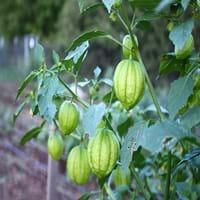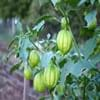Origin
Mexico, Caribbean, Central America
South America, Micronesia, New Zealand
Types
Green Tomatillo, Purple Tomatillo
Not Available
Habitat
Cultivated Beds
coastal environs, Grassland, Roadsides, Waste areas, waterways
USDA Hardiness Zone
6-9
7-11
AHS Heat Zone
12*1
11 - 7
Sunset Zone
A3, H1, H2, 1a, 1b, 2a, 2b, 3a, 3b, 4, 5, 6, 7, 8, 9, 10, 11, 12, 13, 14, 15, 16, 17, 18, 19, 20, 21, 22, 23, 24
H1, 3a, 3b, 4, 5, 6, 7, 8, 9, 10, 11, 12, 13, 14, 15, 16, 17, 18, 19, 20, 21, 22, 23, 24
Habit
Oval/Rounded
Clump-Forming
Flower Color
Yellow, Sandy Brown
Purple
Flower Color Modifier
Bicolor
Bicolor
Fruit Color
Green, Purple, Yellow green
Not Available
Leaf Color in Spring
Green
Green, Light Green, Dark Green
Leaf Color in Summer
Green
Light Green
Leaf Color in Fall
Green
Green, Light Green, Dark Green
Leaf Color in Winter
Not Available
Dark Green, Tan
Leaf Shape
Lance shaped
Grass like
Plant Season
Spring, Summer, Fall, Winter
Spring, Summer, Fall, Winter
Sunlight
Full Sun
Full Sun
Growth Rate
Very Fast
Fast
Type of Soil
Clay, Loam, Sand
Loam
The pH of Soil
Neutral
Acidic, Neutral
Soil Drainage
Well drained
Well drained
Bloom Time
Indeterminate
Summer, Fall
Tolerances
Drought
Drought, Salt
Where to Plant?
Container, Ground
Ground
How to Plant?
Seedlings
Seedlings
Plant Maintenance
Medium
Medium
Watering Requirements
Average Water Needs
Average Water Needs
In Summer
Drought Tolerant, Average Water
Lots of watering
In Spring
Moderate
Moderate
In Winter
Average Water
Average Water
Soil pH
Neutral
Acidic, Neutral
Soil Type
Clay, Loam, Sand
Loam
Soil Drainage Capacity
Well drained
Well drained
Sun Exposure
Full Sun
Full Sun
Pruning
Remove all suckers, Remove wet foliage
Remove damaged leaves, Remove dead branches, Remove dead leaves
Fertilizers
All-Purpose Liquid Fertilizer
All-Purpose Liquid Fertilizer
Pests and Diseases
Fungal Diseases
Red blotch
Plant Tolerance
Drought
Drought
Flowers
Insignificant
Showy
Flower Petal Number
Single
Single
Foliage Texture
Medium
Fine
Foliage Sheen
Matte
Matte
Invasive
Sometimes
Sometimes
Attracts
Birds, Flea beetles
Not Available
Allergy
Arthritis, Inflammation
Itchiness
Aesthetic Uses
Not Used For Aesthetic Purpose
Showy Purposes
Beauty Benefits
Good for skin
Not Available
Edible Uses
Yes
Sometimes
Environmental Uses
Air purification
Air purification
Medicinal Uses
Cancer, Diabetes, Energy, Opthalmic
Not Available
Part of Plant Used
Fruits
Flowers, Leaves
Other Uses
Used for making green salsas and chilli sauce, Used in salads
Animal Feed, Used as Ornamental plant
Used As Indoor Plant
No
No
Used As Outdoor Plant
Yes
Yes
Garden Design
Edible, Herb / Vegetable
Cutflower, Dried Flower/Everlasting, Feature Plant, Foundation, Groundcover, Mixed Border, Screening / Wind Break
Botanical Name
PHYSALIS philadelphica
CORTADERIA jubata
Common Name
Green Tomato, Mexican Groundcherry, Tomatillo
Purple Pampas Grass
In Hindi
Tomatillos
Purple pampas grass
In German
Tomatillos
Lila Pampasgras
In French
Tomatilles
Pourpre herbe de pampa
In Spanish
Tomatillos
hierba púrpura pampas
In Greek
Tomatillos
Μωβ γρασίδι παμπάς
In Portuguese
Tomatillos
grama roxa pampas
In Polish
Tomatillos
Purpurowy trawa pampasów
In Latin
Tomatillos
Purpura Pampas herba
Phylum
Magnoliophyta
Magnoliophyta
Class
Magnoliopsida
Liliopsida
Family
Solanaceae
Poaceae
Genus
Physalis
Cortaderia
Clade
Angiosperms, Asterids, Eudicots
Angiosperms, Commelinids, Monocots
Tribe
Physaleae
Not Available
Subfamily
Solanoideae
Not Available
Number of Species
Not Available
Not Available
Season and Care of Tomatillo and Purple Pampas Grass
Season and care of Tomatillo and Purple Pampas Grass is important to know. While considering everything about Tomatillo and Purple Pampas Grass Care, growing season is an essential factor. Tomatillo season is Spring, Summer, Fall and Winter and Purple Pampas Grass season is Spring, Summer, Fall and Winter. The type of soil for Tomatillo is Clay, Loam, Sand and for Purple Pampas Grass is Loam while the PH of soil for Tomatillo is Neutral and for Purple Pampas Grass is Acidic, Neutral.
Tomatillo and Purple Pampas Grass Physical Information
Tomatillo and Purple Pampas Grass physical information is very important for comparison. Tomatillo height is 60.00 cm and width 90.00 cm whereas Purple Pampas Grass height is 90.00 cm and width 120.00 cm. The color specification of Tomatillo and Purple Pampas Grass are as follows:
Tomatillo flower color: Yellow and Sandy Brown
Tomatillo leaf color: Green
Purple Pampas Grass flower color: Purple
- Purple Pampas Grass leaf color: Green, Light Green and Dark Green
Care of Tomatillo and Purple Pampas Grass
Care of Tomatillo and Purple Pampas Grass include pruning, fertilizers, watering etc. Tomatillo pruning is done Remove all suckers and Remove wet foliage and Purple Pampas Grass pruning is done Remove damaged leaves, Remove dead branches and Remove dead leaves. In summer Tomatillo needs Drought Tolerant, Average Water and in winter, it needs Average Water. Whereas, in summer Purple Pampas Grass needs Lots of watering and in winter, it needs Average Water.





